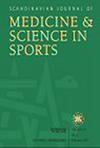限制血流阻力运动与神经肌肉运动对成年膝关节骨性关节炎患者自我感知的膝关节疼痛、功能、生活质量以及功能表现和疼痛敏感的客观测量的影响——一项随机对照试验
IF 3.8
2区 医学
Q1 SPORT SCIENCES
引用次数: 0
摘要
膝关节骨性关节炎(knee- oa)的标准康复包括患者教育和神经肌肉锻炼(NEMEX)。大负荷阻力训练(HLRT)已经显示出对疼痛、功能和肌肉质量的积极影响,但膝关节oa可能会引起疼痛。低负荷血流量限制阻力运动(BFR-RE)显示出与hrt相当的效果,而不会促进运动引起的疼痛。因此,本研究考察了BFR-RE与NEMEX对膝关节炎患者自我感知的膝关节疼痛、功能表现和疼痛敏感的影响。96名症状性膝关节炎患者(年龄56.7±7.6岁;49名女性,47名男性)被随机分为12周双周BFR-RE或NEMEX组。BFR-RE在总动脉闭塞压的60%-80%进行。对照组参与者完成了为期12周的NEMEX项目。两组患者都参加了患者教育。主要结局:膝关节损伤和骨关节炎结局评分(oos)疼痛亚量表从基线到12周的变化。次要结局:剩余kos亚量表、牛津膝关节评分(OKS)、30秒坐立(STS)、STS功率、4 × 10米快速步行(4 × 10米- fwt)、爬楼梯测试(SCT)、压痛阈值(PPT)测量的扩散和局部疼痛敏化。KOOS- pain的变化(+6.4分,95% CI = -1.0-13.7,效应量(ES) = 0.35, p = 0.07),其余KOOS子量表和OKS的变化(ES = 0.05-0.20, p > 0.05)组间无显著差异。BFR-RE在所有功能指标(STS、STS功率、4 × 10 m FWT、SCT) (ES = 0.89-1.56, p < 0.01)和扩散致敏性(ES = 0.43-0.55, p < 0.05)均优于NEMEX。BFR-RE和NEMEX在减轻膝关节疼痛方面同样有效,而BFR-RE在中度膝关节炎患者的功能表现和改善扩散敏化方面取得了更大的统计收益。与NEMEX相比,BFR-RE的增强改善代表了未来治疗膝关节炎应考虑的新见解。本文章由计算机程序翻译,如有差异,请以英文原文为准。
Effects of Blood-Flow Restricted Resistance Exercise Versus Neuromuscular Exercise on Self-Perceived Knee Pain, Function, Quality of Life, and Objective Measures of Functional Performance and Pain Sensitization in Adults With Knee Osteoarthritis-A Randomized Controlled Trial.
Standard rehabilitation for knee osteoarthritis (knee-OA) combines patient education and neuromuscular exercises (NEMEX). Heavy-load resistance training (HLRT) has shown positive effects on pain, functionality, and muscle mass, but can be painful with knee-OA. Low-load blood-flow restricted resistance exercise (BFR-RE) has shown comparable effects to HLRT without promoting exercise-induced pain. Therefore, the present study examined the effect of BFR-RE vs. NEMEX on self-perceived knee pain, functional performance, and pain sensitization in knee-OA individuals. Ninety-six participants (age 56.7 ± 7.6; 49 females, 47 males) with symptomatic knee-OA were randomized to 12 weeks biweekly BFR-RE or NEMEX. BFR-RE was performed at 60%-80% of total arterial occlusion pressure. Control participants completed a 12-week NEMEX program. Both groups also attended patient education. Primary outcome: Change in the Knee injury and Osteoarthritis Outcome Score (KOOS) pain subscale from baseline to 12 weeks. Secondary outcomes: Remaining KOOS subscales, Oxford Knee Score (OKS), 30-s sit-to-stand (STS), STS power, 4 × 10 m fast-paced walking (4 × 10 m-FWT), stair climb test (SCT), spreading and local pain sensitization measured as pressure pain thresholds (PPT). No significant between-group difference in the change in KOOS-Pain was observed (+6.4 points, 95% CI = -1.0-13.7, effect size (ES) = 0.35, p = 0.07) or the remaining KOOS subscales and OKS (ES = 0.05-0.20, p > 0.05). BFR-RE demonstrated greater improvements than NEMEX for all functional outcomes (STS, STS power, 4 × 10 m FWT, SCT) (ES = 0.89-1.56, p < 0.01) and spreading sensitization (ES = 0.43-0.55, p < 0.05). BFR-RE and NEMEX were equally effective in reducing knee pain, while BFR-RE achieved greater statistical gains in functional performance and improved spreading sensitization in persons with moderate knee-OA. The enhanced improvements with BFR-RE compared to NEMEX represent novel insights that should be considered in future treatments of knee-OA.
求助全文
通过发布文献求助,成功后即可免费获取论文全文。
去求助
来源期刊
CiteScore
7.90
自引率
4.90%
发文量
162
审稿时长
3 months
期刊介绍:
The Scandinavian Journal of Medicine & Science in Sports is a multidisciplinary journal published 12 times per year under the auspices of the Scandinavian Foundation of Medicine and Science in Sports.
It aims to publish high quality and impactful articles in the fields of orthopaedics, rehabilitation and sports medicine, exercise physiology and biochemistry, biomechanics and motor control, health and disease relating to sport, exercise and physical activity, as well as on the social and behavioural aspects of sport and exercise.

 求助内容:
求助内容: 应助结果提醒方式:
应助结果提醒方式:


